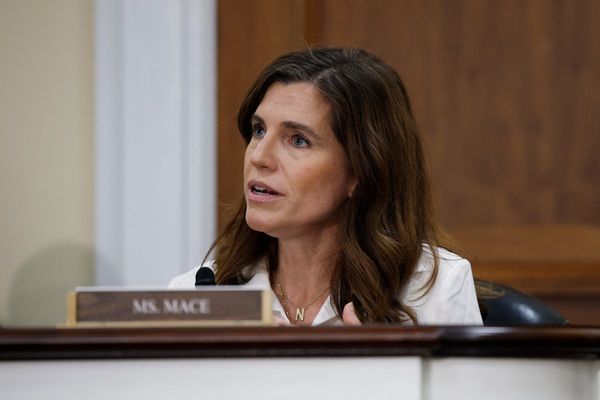
Images of AR-15 semi-automatic rifles are everywhere in American public life: Republican congressmen sport lapel pins shaped like AR-15s. Confederate flags with the silhouette of an AR-15 and the phrase “come and take it” flew outside the Capitol during the January 6 insurrection. They are also used to evoke the need for stricter gun safety measures.
On Saturday, the AR-15 re-entered American politics in another way – as the weapon used in the assassination attempt of former president Donald Trump.
“A gun that his party has touted, someone just used it to try to kill him,” Cameron McWhirter, a journalist and co-author of the book American Gun: The True Story of the AR-15, told the Guardian on Monday. “Will that change things? I think we’re all sort of wondering.”
The AR-15 is a weapon of war, designed to be lightweight, easy to fire and carry in the field. It’s also a central symbol in the US gun debate, a potent cultural and political emblem that’s invoked by both the right and the left. Will Trump’s assassination attempt change the way it is seen?
“It puts everything sort of in flux,” said McWhirter. “The gun debate was not dominating the presidential race. This latest crisis brings it back to the fore.”
What is an AR-15?
The AR-15 is one of the most popular – and ubiquitous – firearms in the US, with close to 25 million in civilian hands, according to McWhirter.
It’s been used in high-profile mass shootings, including the Uvalde, Texas, school shooting in 2022, the Parkland, Florida, high school shooting in 2018, the Las Vegas music festival shooting in 2017, the Orlando nightclub shooting in 2016, and the Newton, Connecticut, elementary school shooting in 2012.
McWhirter said the impetus he and co-author Zusha Elinson, both reporters at the Wall Street Journal, shared to write their book was the repeated use of AR-15s in these acts of violence. “We were covering mass shootings, and as soon as we heard about one, we would ping each other, ‘Was it an AR-15?’” he said. “Increasingly, the answer was ‘yes.’”
The origins of this deadly weapon can be traced back to the 1950s, when a former marine named Eugene Stoner sought out to design a lightweight, easy-to-shoot rifle for the US military to go up against guerrilla fighters armed with AK-47s.
As Elinson told the Guardian last year: “The final result was a gun that could fire a lot of bullets really rapidly, was extremely easy to shoot and keep on target. And it was just what some people in the military wanted.”
Eventually, the gun company Colt started selling a civilian version.
How did AR-15s become so popular – and ubiquitous?
AR-15s are legal in all 50 states. (Some states, including California, have restrictions on magazine size and modifications that can be used with them.) “It’s very easy to buy an AR-15 in this country,” McWhirter said.
Elinson called the popularity of AR-15s an “accident of politics”. High crime rates in the 80s and 90s sparked a movement against military-style, semi-automatic guns, and in 1994, President Bill Clinton signed the Federal Assault Weapons Ban, with bipartisan support.
The ban had the paradoxical effect of elevating the status of the AR-15, Elinson said: “It became a line in the sand, a symbol of second amendment rights and it drew a lot of people to the gun.”
In 2004, the Republican-led Congress allowed the assault weapons ban to sunset. McWhirter told the Guardian last year: “As soon as it went away, a lot of the larger gunmakers who resisted them all jumped in, because the profit was too tempting. AR-15s are easy to make and you can ramp up and reduce production really quickly. All these things are very attractive. Simultaneously, both of these things come together with this military macho aspect of our ‘war on terror’ to send sales of the AR-15 through the roof.”
Thirty years after the federal assault weapons ban, the AR-15 continues to be a potent cultural and political symbol at the center of political fights over gun safety and access.
“The AR-15 is a gun that’s become this iconic emblem that everyone in America wants to fight over,” McWhirter said. “This gun has become the emblem of the gun rights movement. At the same time, it’s become the emblem of people calling for stricter gun laws and things that have gone wrong in America regarding guns.”
What happens next?
The attempted assassination of Trump this weekend will inevitably reinject the gun debate into the presidential race, McWhirter said, although it is not clear yet how it will play out.
Will Republicans give up the AR-15 as a political symbol and crack down on assault weapons?
Previous assassination attempts have led to gun legislation. Following the attempted assassination of Ronald Reagan in 1981, Congress passed the Brady Handgun Violence Prevention Act - named after staffer James Brady who was also shot - which required background checks and imposed a five-day waiting period on gun purchases.
But that doesn’t mean it’s going to happen again this time around, McWhirter said.
“Former president Trump was almost killed on Saturday,” he said. “That should be a moment, no matter what your political views, to say, ‘Where are we going as a country and what should we do to have a better, safer place that we all want to live in?’
“One of the things we’re going to have to grapple with, besides political division, is the prevalence of guns,” he said.







